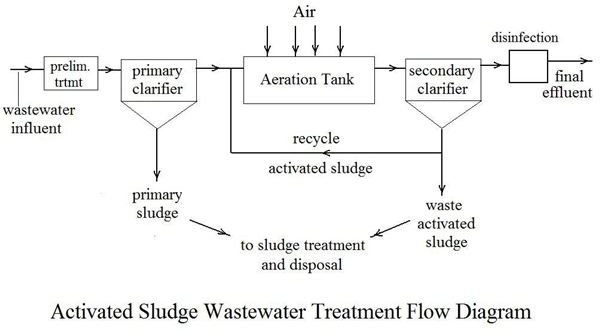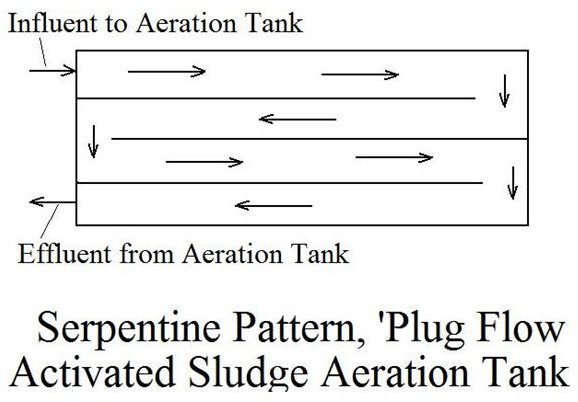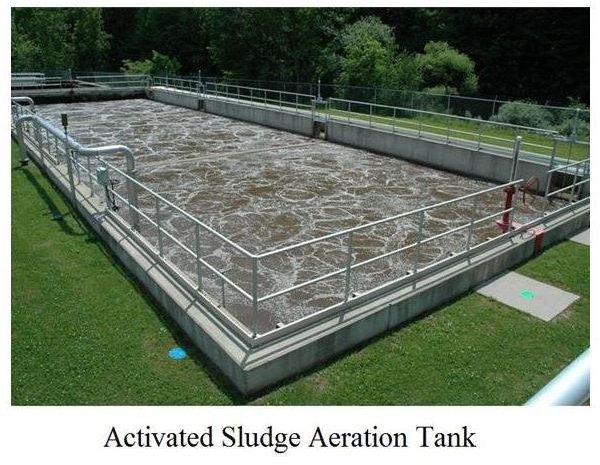Removal of Biochemical Oxygen Demand with Activated Sludge Waste Water Treatment Systems
Overview of the Activated Sludge Process
There are several variations of activated sludge biological wastewater treatment systems, but all are designed and operated to remove suspended solids and organic matter (biochemical oxygen demand or simply BOD) from wastewater. Most variations of the activated sludge process include a primary clarifier to remove settleable suspended solids first. Then biological oxidation is carried out in the aeration tank to oxidize organic pollutants in the wastewater to the innocuous end products, carbon dioxide and water, thus removing biological oxygen demand.
The major function of the aeration tank is to put the organic matter in the wastewater into contact with dissolved oxygen and aerobic
bacteria, so that biological oxidation of the organic matter will take place. The aeration tank is typically kept aerated to maintain adequate dissolved oxygen by blowing air into the tank through diffusers. The essence of the activated sludge process (invented in England in 1914) is maintaining an adequate concentration of aerobic bacteria in the aeration tank by settling out the aerobic bacteria in a secondary clarifier and recycling most of them back into the aeration tank. This process is selective for aerobic bacteria that flocculate and form settleable solids that will thus settle out in the secondary clarifier. Only those aerobic bacteria that settle out are recycled back to the aeration tank and non-flocculating aerobic bacteria are washed out of the system. Flow diagrams for several activated sludge variations, showing the aeration tank, clarifiers and flow patterns, are given in the rest of this article.
Image Credit: T. Simmons/Indiana University of Pennsylvania
Activated Sludge Process Variations
Four variations of activated sludge biological wastewater treatment systems will be described briefly in this article. Those four variations are:
- Conventional activated sludge
- Extended aeration
- Completely mixed activated sludge
- The contact stabilization process
Conventional Activated Sludge Waste Water Treatment Systems

The conventional activated sludge process can be used over a wide range of wastewater flow rates, from small to very large biological wastewater treatment plants. The major components of a conventional activated sludge system (a primary clarifier, an aeration tank, and a secondary clarifier) are shown in the flow diagram at the left. Each has a function to serve in the overall biological wastewater treatment process. The primary clarifier removes settleable organic solids, which go to sludge treatment and disposal processes. (Inorganic grit, if present, should have been removed as part of the pretreatment processes.)
The aeration tank brings organic containing wastewater, aerobic bacteria and dissolved oxygen into contact so that biological oxidation breaks the organic matter down into carbon dioxide and water. The

wastewater/aerobic bacteria flow is kept mixed and aerated by air blown in through diffusers.
For the conventional activated sludge process, the aeration tank is typically designed with a long, narrow configuration so that the wastewater flow through the tank approximates ‘plug flow’. For large activated sludge wastewater treatment systems, the aeration tank is often built with a serpentine pattern, as shown in the diagram at the right, to give the desired plug flow without an excessively long tank.
Extended Aeration Activated Sludge Waste Water Treatment Systems

The extended aeration activated sludge process, as shown in the diagram at the left, doesn’t use a primary clarifier. A longer detention time in the aeration tank is substituted, so the settleable organic matter (which remains in the wastewater) will be biologically oxidized in the aeration tank along with the dissolved and fine suspended matter. The aeration tank for an extended aeration process must be larger than that for a conventional activated sludge process, in order to give a detention time of about 24 hours instead of the 6 to 8 hours used for a conventional activated sludge process. The operation of the plant is simplified, however, due to elimination of the primary clarifier and the sludge treatment and disposal that goes with it.
Completely Mixed Activated Sludge Waste Water Treatment Systems
Completely mixed activated sludge waste water treatment systems have the same

overall flow diagram as the conventional activated sludge process. The primary differences are the configuration of the aeration tank and the method by which it is mixed/aerated. For this option, the aeration tank is usually mixed/aerated with a mechanical mixer, as indicated in the diagram at the right, instead of with air blown in through diffusers. The tank geometry and mechanical mixing are designed to approximate a completely mixed reactor instead of a plug flow reactor as with the conventional activated sludge process. The main applications for the completely mixed activated sludge process are cases where slug flows of high concentration waste or hard to oxidize waste enter the plant. The complete mixing dilutes such flows into the entire tank contents more rapidly than a plug flow design.
Contact Stabilization Activated Sludge Wastewater Treatment Systems

The contact stabilization activated sludge process requires less total aeration tank volume than the conventional activated sludge process. This is accomplished by treating the full wastewater flow for only 0.5 to 2 hours in an aerated ‘contact’ tank. In order to complete the biological oxidation process (removal of biochemical oxygen demand), the recycled activated sludge (a smaller flow rate than the full wastewater flow) is aerated for 3 to 8 hours in a ‘stabilization’ tank. For a given influent waste water flow rate, the total volume of the contact tank and stabilization tank for the contact stabilization process is typically less than the conventional activated sludge aeration tank volume needed for the same flow rate. The flow diagram at the left shows this process.
Summary
The four types of activated sludge wastewater treatment systems covered in this article are the most widely used variations. All bring dissolved oxygen, waste organic matter, and aerobic bacteria into contact with each other in an aeration tank in order to bring about biological oxidation and remove biological oxygen demand from the wastewater. For coverage of activated sludge design and operation calculations with Excel spreadsheets that can be downloaded, see the article, “Download Excel Spreadsheets for Activated Sludge Waste Water Treatment Calculations.”
References
1. Metcalf & Eddy, Inc, (revised by Tchobanoglous, G, Burton, F.L., Stensel, H.D., Wastewater Engineering Treatment and Reuse, 4th Edition, New York, NY, 2003.
2. Grady, C.P.L., Daigger, G.T., Lim, H.C., Biological Wastewater Treatment, 2nd Edition, New York, NY, Marcel Dekker, Inc., 1999.
3. Vesilind, P.A. and Morgan, S.M., Introduction to Environmental Engineering, 2nd Edition, Belmont, CA, Brooks/Cole, 2004.
This post is part of the series: Information on Wastewater Treatment
This series will provide information on wastewater treatment, its processes, and the specific methods used at wastewater treatment plants to remove pollutants from the water.
